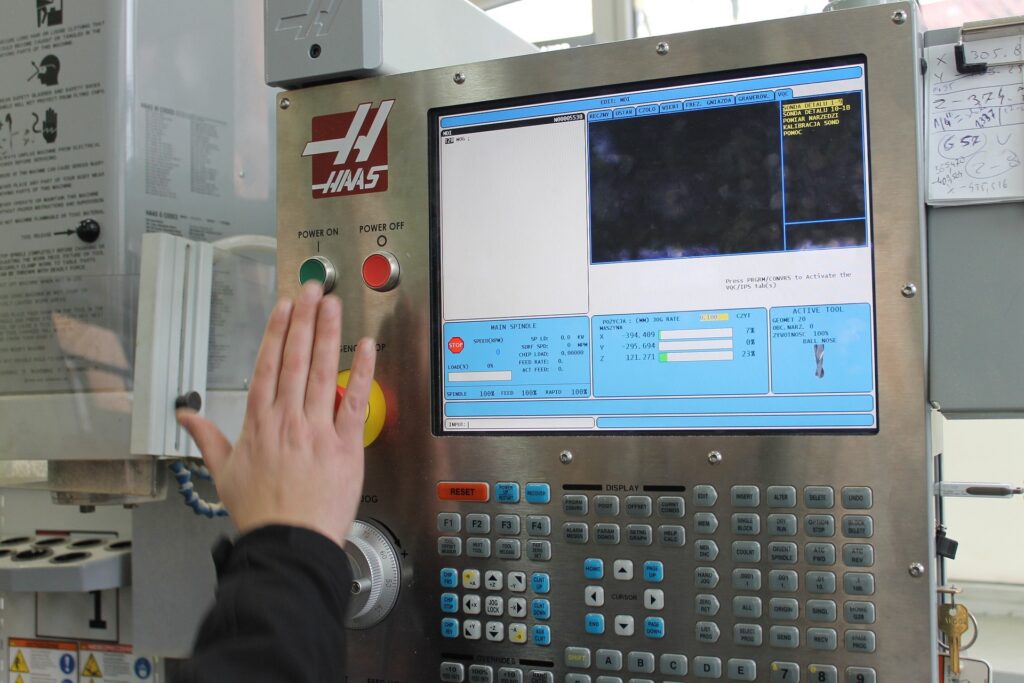What is computer numerical control, and why do some manufacturers rely on it for high-quality outcomes? Learn about CNC and how it bolsters rapid prototyping, additive manufacturing, and other advanced fabrication processes.
What is computer numerical control (CNC), and how do manufacturers use it to gain a competitive advantage? Many adopt CNC techniques and machining to enhance product designs or achieve complex geometries after rapid prototyping. The more you know, the better your chances of leading the market with high-quality products.
Today’s manufacturing industry requires strict adherence to specific standards. However, some of those standards can get in the way of innovation. CNC helps engineers develop upgrades while remaining compliant across multiple industries. This article will take a closer look to answer what is CNC and why it matters.
Table of Contents
What Is Computer Numerical Control?
How Does Computer Numerical Control Work?
What Is Computer Numerical Control vs. CNC Machining?
Computer Numerical Control Types
Computer Numerical Control Applications
5 Benefits of Computer Numerical Control
#2. Increased Design Precision
#4. Faster Large-Scale Production
What Is CNC Compared to Rapid Prototyping?
How to Take Advantage of Computer Numerical Control for Manufacturing
Step 1 – Determine Your Design Parameters and Material Requirements
Step 2 – Pay Attention to the Real-Time CNC Analyses
Step 3 – Consult an Expert in Computer Numerical Control and Rapid Prototyping
What Is Computer Numerical Control?
Asking a rapid prototyping expert what is computer numerical control makes sense. Also known as CNC, it is essential for modern manufacturing. It describes a highly regulated method of automating machine tools with microcomputers featuring embedded software.
The approach sounds more complicated than it is. CNC allows engineers to control various fabrication devices with a computer. For example, teams might use computer numerical control to process sheet metal and other materials after the rapid prototyping phase. It is crucial for industrial robotics, multi-axis machining, and other manufacturing technologies.

We offer fast, high-quality, tailored PROTOTYPING solutions for leading companies in a wide range of industries.
superior Rapid PROTOTYPING
Manufacturers can use CNC to machine metal and plastic components for fast implementation.
“With rapid prototyping and additive manufacturing, CNC supports innovative product development by shortening lead times with computer-integrated manufacturing for precision outcomes.”
Computerized manufacturing machines process materials based on goal-based specifications. They use coded programmed instructions and manual operations to produce high-speed results without human error. Meanwhile, operators assign a unique and custom computer program for each manufactured or modified object. This helps teams make predictions and troubleshoot before mass production.
How Does Computer Numerical Control Work?
Understanding CNC helps improve modern manufacturing and enhances the customer experience. Here is how it works:
- Teams wanting to make something with CNC write a customized program. This computer code, or G-code, outlines the project’s objectives step-by-step.
- Engineers create a computer-aided design (CAD) using advanced CNC software and rapid prototyping. This allows them to evaluate and adjust features efficiently.
- Operators load the three-dimensional drawings onto a microcontroller unit (MCU). This lets teams determine the necessary instruments and machines for each operation.
A CNC operator will take it from there. Experts in CNC can test machinery, programming, and material placement before initiation. Some might refine the CNC programs to achieve specific team goals or industry expectations and eliminate snags.
Afterward, the computer numerical control machines complete orders as directed in the G-code. This means the tools will cut materials or print something without manual interference. Streamline projects and increase productivity with CNC machining.
What Is Computer Numerical Control vs. CNC Machining?
What is CNC compared to CNC machining, and why is it important to know the difference? CNC machining is the process, but CNC is the primary tool. In other words, computer numerical control technologies are essential to CNC machining methods.
For example, some automobile manufacturers mass-produce parts. That means engineers can’t hand-cut their inventories because it would take too long and tedious. CNC machining technologies let them create high-quality car parts using durable tools, dependable programs, and industry-standard materials.
“CNC programs help experts transform design templates from software into usable components using CNC machining processes.”
This allows operators to quickly cut or form materials into different shapes with repeatable techniques. The increased productivity and accuracy mean less expensive manufacturing and more significant improvements.
Computer Numerical Control Types
What is CNC, and what are the primary CNC tool types for modern manufacturing? CNC involves automated machining instruments like drills, grinders, and 3D printers. Experts can control various aspects using CAD software and a clear ISO strategy.
Many manufacturers also use CNC routers, milling machines, and lathes to create intricate geometries and meet tight tolerances. Ask your team how advanced computer numerical control programs, techniques, and tools can help you meet goals.
Computer Numerical Control Applications
The following questions are: what is CNC, and what applications are available for competitive manufacturers? Since CNC plays a significant role in aviation, automotive, medical, and other essential industries, its applications are numerous. The benefits and approach depend on project goals and the desired outcomes.
CNC is a subtractive manufacturing process. It cuts away specific portions of a workpiece to form different shapes. Manufacturers must determine appropriate materials according to ISO regulations and consumer expectations or risk wasting resources. Fortunately, computer numerical control also helps engineers streamline design and production for more sustainability.
5 Benefits of Computer Numerical Control
What is computer numerical control if not a foundation for today’s economy? ISO standardization in manufacturing allows innovation without sacrificing quality. CNC machining offers practical solutions and consistent results. This trifecta is essential to community growth, business success, and marketing.
Before CNC, people had to manage complex machining processes and product design by hand. This was dangerous, inefficient, and expensive. In the interim:
“…the precision tools required for manufacturing also require fabrication, so the entire system would collapse without computer numerical control.”
Here are some other CNC benefits to consider:
#1. Better Cost-Effectiveness
Manufacturing without waste can be challenging. You automatically create scrap when fabricating metals, plastics, and other materials with CNC machining. However, CNC helps you cut costs by revealing actionable steps for better resource management. Combine CNC with rapid prototyping to save even more.
#2. Increased Design Precision
What is CNC when you’re trying to create detailed designs? It is the backbone of your blueprint and the tool to develop exceptional items. CNC and CNC machining help teams peer into CAD files and adjust features during the early stages. This prevents costly or time-consuming oversights and helps ensure top-notch results despite the obstacles and variables.
#3. Fewer Flaws and Mistakes
Automated and robotic manufacturing means more precision with less scrap. It doesn’t remove the human element; it enhances manual work and logistics while supporting innovation by managing the mundane. AI and machine learning allow CNC programs to collect data, analyze inputs or outputs, and share real-time feedback.
#4. Faster Large-Scale Production
Unlike humans, machines don’t get tired and need a break. Operators can run CNC machines for hours without stopping. The tools and techniques can also help teams complete massive orders quickly and with measurable uniformity. This allows companies to introduce innovations ahead of the competitive curve while fostering industry authority with consistently high-quality products.
#5. Improved Product Outcomes
Better cost-effectiveness, increased design precision, fewer flaws, and faster turnarounds equal improved outcomes and profitability. Manufacturers can create virtually anything using CNC, CNC machining, rapid prototyping, and additive manufacturing. They can also enjoy flawless finishes and immediately usable inventories ready for widespread distribution.
What Is CNC Compared to Rapid Prototyping?
CNC can get confused with rapid prototyping because they both have similar goals. However, understanding the differences is crucial. Efficient manufacturing requires using the best and most appropriate tools. Teams must also recognize a cost-effective approach when they see one and put it to work.
Rapid prototyping (RP) and CNC go together, although they’re separate processes. Engineers use rapid prototyping to design specific products and troubleshoot elements. However, that wouldn’t be possible without CNC programming and advanced automated machining, robotics, and AI to control the machines.
How to Take Advantage of Computer Numerical Control for Manufacturing
Taking advantage of CNC means you gain a competitive edge against other teams in your industry.
“CNC allows you to determine design parameters, define materials, isolate specific functions, and exceed market expectations.”
Automation also removes human error and provides more consistency for mass manufacturing.
CNC is closely related to rapid prototyping because operators must use CNC software (CAD, etc.) to develop three-dimensional models. They can then transfer computerized representations into microprocessors that control machining tools. This boosts productivity, increases speeds, and decreases manufacturing costs. Garnering the benefits is essential to remain relevant and profitable.
Here are three simple steps you can take to profit from CNC:
Step 1 – Determine Your Design Parameters and Material Requirements
CNC programs will do whatever the G-code says. Still, some instructions might not work for particular materials and designs. You must coordinate the various features and accommodate required adjustments to avoid waste. C machining is not cheap, nor is scrapping materials and starting projects from scratch.
Step 2 – Pay Attention to the Real-Time CNC Analyses
Many CNC programs use artificial intelligence (AI) to run machines. This helps eliminate redundancy and unnecessary steps. However, many CNC machines can also analyze project data during various production phases. Teams can use real-time suggestions to make opportune changes without performing extra calculations.
Step 3 – Consult an Expert in Computer Numerical Control and Rapid Prototyping
CNC professionals know how to determine the most appropriate steps for your project. They can align productional goals with industry standards and consumer demands for more profitable outcomes. Experts can also help uncover hidden design flaws and offer suggestions or cost-effective solutions.
FACT: You can get an instant quote on many manufacturing projects by downloading a file created with computer numerical control.
Conclusion
What is computer numerical control, and why is it essential for modern manufacturing? The answers are evident in today’s thriving economy. Competitive manufacturers rely on CAD software, CNC machining, and rapid prototyping to keep the ball rolling across all industries. They also use ISO standards to ensure excellence despite evolving expectations.
CNC bolsters manufacturing efforts from rapid prototyping to the final inspection. It helps regulate processes and reveal issues ahead of production. Learn the benefits of CNC, RP, and 3D printing for optimal outcomes.
Talk to a CNC machining and rapid prototyping expert for more information. Decide how you want to approach manufacturing standards in your industry, then reach out to professionals for a cost-effective strategy.
 About the Author
About the Author
James Murphy is the founder and CEO of HLH Rapid – a hybrid CNC machine shop fusing Western service and quality with Eurasian industry influences for over 14 years. His advanced enterprise uncovers cost-effective rapid injection molding techniques to remain unmatched by industry competitors. Murphy’s full-service fabrication and manufacturing methods span six dedicated zones, from 3D printing and vacuum casting to sheet metal prototyping and project management. His expertise also includes high-efficiency machining within strict yet volatile markets.
Murphy earned an MBA after becoming inspired by his father’s hands-on craftsmanship. As a budding entrepreneur, he taught English and studied Chinese to pursue pioneering objectives. His groundbreaking approach helps build the future by providing well-rounded manufacturing services to innovative Western businesses. When he’s not offering upscale RP and CNC, James enjoys art-house movies, Thai boxing, and spending time with his growing family.
Visit HLHRapid.com for an instant quote on rapid prototyping services.


